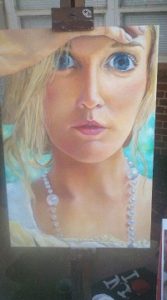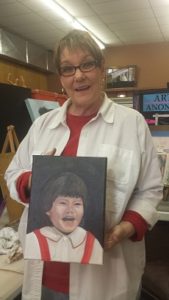The Winning Attitude
Paint-through, a new term that I think I’ve created is cannibalized from the book marketing sector to apply to painting. Besides being a writer, I’m an art teacher of 30-some years. Writing webinars that tell you about click-through and read-through referring to number of one-author books a reader reads through prompted the term ‘paint-through,’ or what it takes to finish a painting, an art course or a stretch of growth as an artist.

Allison Coleman, Girl with Pearl Necklace
As a lifelong artist and art teacher, I have taught thousands of students. I’ve had art school graduates return for lessons–in one case, to learn how to paint a pearl that was three dimensional. She began lessons with me for a second time and took art several years before returning for her art masters to UNC-Chapel Hill Graduate School. I have the advanced knowledge and taste discrimination that a teaching visual artist needs to guide those who want to learn art basics. I have helped develop artists’ skilled expression of their talent. But I had a foundation of many years of art training in high school, college, correspondence art school, and then in Germany, in Old Masters’ watercolor (Polish master Leon Jonczyk) and oil painting (German master Bergheim). Plus, I came from a supportive family–but a critical one.
My grandmother thought an artist was born, not made. Even as a young person I argued with her, “Grandma, artists are made, not born.” I’ve taken a multitude of lessons over the years to back that up (and grow).
In my years of experience, what keeps so many would-be artists from actualizing hinges more on attitude than talent.
Yet what is the number one question asked me by parents, but whether or not I think their child has talent. Frequently, the boosting agency of parents as in ‘she has so much talent’ I find more harm than help, a vaccine against input from those experienced enough to teach you more. Talent is a given. A starting place. Skill is what you want to achieve with the talent you were given, not the ‘fun’ or pleasure you derive from it, also a given, I would hope. It is disheartening to a teacher to get a student who only wants praise and never input, who cries at the drop of a pencil. Many times they want a particular artist’s style, or a pretty look, but they aren’t willing to work hard to get it. They don’t even care if they understand or not. They get discouraged and blame it on someone else who didn’t give them what they wanted. Many put their talent into cold storage.
Would-be artists put their talent in the deep freeze in one of several ways.
Seven good ways not to develop talent:
* Never use it.
* Don’t take courses, after all, it’s just a matter of drawing/painting what you see.
* Never-ever listen to your art teacher. I mean he or she still makes mistakes, doesn’t she?
* Never take critique. All your friends tell you just how great you are, how dare anyone mention a new idea, direction, art concept, way?
* Counting a sale as a statement of artistic merit, rather than the boost to ego and pocketbook it is.
* Cultivate the noble savage notion–that greatness springs forth from babes like a trial run of America Has Talent.
*Take from a teacher who only praises you, plays, and never shows you anything new.
So what sort of attitude is one that will enhance your art growth and create healthy improvement in your art? First of all, you need to look at good art. Educate your senses–disputing taste is different from developing your taste. That’s the basis of experiential art knowledge. If you refuse to look beyond coloring books and bad illustration, it’s hopeless. You need to view paintings and drawings of truly great artists, not only commercial, not to discourage but to inspire you. And above all to train your eye. Delight in nearby museums, galleries, and ateliers growing up around the country and whose artists’ works you can access on-line. Look at them daily.
THE SIX “D’s” or DECISIONS THAT GUARANTEE GROWTH
Number 1. Determination.
Is that a synonym for paint-through? Partly. It certainly takes determined effort to make it past the potholes of life and art. Determination is a hard factor that may grate on personality and impinge on creativity over time. It may translate to action, but it doesn’t of itself guarantee the action will be coordinated, planned or building-block. Without more it might just be a scattershot, hit or miss thing, sporadic, this determination.
Number 2. D for Dogged.

Stuart Peregoy, Landscape
That’s quite similar in many ways to determined, but says more repetitive attempts and new trials. It’s sticking to it with a glue-like persistence which is admirable. You can get so dogged that your brains fall out, your insights dull, and your patterns become non-productive. So now, we add dogged to determined, but there’s more.
Number 3. Delivery.
This attitude lifts you up to the high spots, the aha moments, the tripping lightly from stone to stone in an ever-increasing stairway to the stars. As long as you are on an emotional high this can carry you quite a-ways. So we can add delivery to dogged and determined. But there’s gotta be more.
Number 4. Delight.
Now here’s a new idea altogether. Delight. What delights you? This is worthy of a great deal of morning pages (thanks to my book friend, Julia Cameron, author of The Artist’s Way, I’ve been doing this most every morning for years and years. By doing this exercise you explore your psyche and learn to be honest with yourself and turn into your own best friend. You tell yourself all your secrets. You see what irks you beyond belief, what makes you actually smile when you think of it–the feel of pain, the smells that evoke certain emotions, the particular images you like and speak to you. So we add delight to our attitude, and that’s it? Not really; there’s more.
Number 5. D for Discovery.
Exploration, adventuring forward on a question is a way of turning the control knob down on fear and trepidation. it’s a way of opening the door to new ways of expressing old loves, not waiting until you’re ready but plunging in, diving into it. Waiting until I have money, waiting until I have my project defined. Waiting, waiting, waiting, until the cobwebs form. We want each new project to be a voyage of discovery, exciting and unknown.
Add all these things together to give yourself a lively attitude, but you also need the discipline of an apprentice.

Betsy Bradshaw Paints Son in Oils in a Day
Number 6, Discipline which comes from disciple.
You need to make yourself a loyal apprentice to someone who knows way more than you do, learn solid principles of color, design, perspective, figure and face drawing. You need humility not to be prickly, to take tips from an expert who can teach you. That will keep you from embarrassing yourself and from being a dilettante or turning out half-baked as an artist. Hard words to live by in a ‘do-it-yourself’ world with an attitude of ‘you can’t tell me anything.’
Growing up and achieving “paint-through” results in a satisfied student with an excellent portfolio who brags on her teacher and the corrections and teaching they have honed their art through. Hmmm, another coined word, ‘art-through’?
Learn more »
